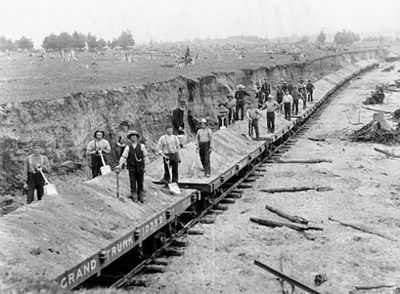The General Agreement on Tariffs and Trade (GATT) was an international trade agreement. It was signed by 23 nations, including Canada, in 1947. It came into effect on 1 January 1948. The GATT was focused on trade in goods. It aimed to reduce tariffs and remove quotas among member countries. The GATT helped reduce average tariffs from 40 per cent in 1947 to less than five per cent in 1993. The GATT was an early step toward globalization. The World Trade Organization (WTO) replaced the GATT on 1 January 1995.
This article is a plain-language summary of the General Agreement on Tariffs and Trade (GATT). If you are interested in reading about this topic in more depth, please see our full-length entry, General Agreement on Tariffs and Trade (GATT).
Sixth Round of GATT Negotiations
The sixth round of GATT negotiations, known as the Kennedy Round, in Geneva, Switzerland, 4 May 1964.
(photo by -/AFP via Getty Images)
Why Was the GATT Created?
The GATT’s purpose was to regulate world trade. It was created to boost the global economy after the Second World War. Its aim was to reduce or remove trade tariffs, quotas and subsidies. A tariff is a tax on goods and services that are traded between countries. A tariff can make goods or services from another country more expensive to import (to bring into a country). A tariff can help protect domestic or local businesses (see Protectionism). A quota is a limit. A quota can limit the number or value of goods bought or sold. A subsidy is a sum of money that governments will give to companies or industries to keep the price of goods and services low.
During the Great Depression, international relations broke down. An increase in trade rules and protectionism made a bad global economy worse. These factors helped lead to the Second World War. After the war, the Allies did not want to repeat the same mistakes. They wanted to create economic interdependency. This would increase partnership and reduce the risk of conflict. The idea was to create a code of conduct. This code would remove or loosen trade limits. Within this code of conduct, member nations could make policies and settle conflicts. Data on trade patterns and trends could also be compiled and shared.
The GATT played a key role in the Cold War. It helped the US-led capitalist West create freer trade through multination agreements. The West, which Canada was part of, gained more allies through these agreements. This strengthened the West’s global influence. After the Cold War, the GATT shifted into a truly global organization — the WTO. It let former communist bloc countries, such as Czech Republic, Poland and Romania, become members.
GATT Meetings
The GATT was first discussed at a United Nations conference in 1947. It was there that the idea of creating the International Trade Organization (ITO) was proposed. It was hoped that the ITO would help the World Bank and the International Monetary Fund (IMF) make countries co-operate better. Canada and 22 other nations signed the GATT on 30 October 1947. It came into effect on 1 January 1948.
At first, it was thought that the ITO would be more important than the GATT. But the US backed out of the ITO in 1950. Focus then shifted to the GATT. Eight trade conferences (called rounds) were held between 1947 and 1994. The GATT was created at the first round in 1947.
One-on-One Talks
Canada made one-on-one agreements with seven of the 23 GATT countries. Its talks with the United States were the biggest. Canada had made trade pacts with the US in 1935 and 1938. But once both nations signed the GATT, it became the basic agreement for trade rules between them.
Under GATT rules, a member country must give all other members the same privileges it gave to its most favoured nation (MFN). This was known as the MFN rule. It helped remove trade barriers.
Multinational Trade Groups
Several multination trading groups operated alongside the GATT. These included the Organisation for Economic Co-operation and Development (OECD); the Quadrilateral Group; and the Cairns Group of Fair Trading Nations. Membership in these groups allowed Canada to help steer the direction of trade talks.
The most influential group was the Quadrilateral Group. It was also called the “Quad.” This informal group included Canada, Japan, the US and the European Union. They were the world’s four largest trade bodies at the time. The Quad became a more formal alliance at the 1981 G7 summit. Between 1986 and 1994, also called the Uruguay Round, the Quad pursued agricultural concerns and pushed for the creation of the WTO.
Did Canada get Special Perks?
Some exceptions to the MFN rule were allowed. Canada benefitted from several of them. The US was allowed to enter the Canada-US Automotive Products Agreement (Auto Pact) in 1965. Canada and other developed countries were also allowed to give preferences to developing countries under the Generalized System of Preferences. Canada was also involved in the Multifibre Arrangement (MFA). It allowed developed countries to restrict textile imports from developing countries.
Finally, free trade arrangements among countries were allowed. This opened the door to the Canada-US Free Trade Agreement in 1989 and the North American Free Trade Agreement (NAFTA) in 1994. (See also Canada-United States-Mexico Agreement.)
Imports and Export Subsidies
Generally, GATT did not allow limits on imports and export subsidies. But some exceptions were made. There were two important exceptions for Canada: the MFA; and arrangements for agricultural products. The US wanted the latter to be left out of GATT. Canada and other major agricultural exporters objected. Canada was also against the special waiver the US received in 1955 that allowed it to restrict imports of dairy products. Germany and Switzerland got other waivers to restrict agricultural imports. Canada, too, restricted imports of grains and dairy and poultry products. It also used export subsidies of some dairy products and eggs to dispose of surpluses.
Exclusions and waivers from GATT produced a maze of restrictions on agricultural imports and export subsidies. These have plagued global production and trade in these product lines ever since.
The GATT also forbid the practice of dumping. Dumping is when products are sold abroad for less than they are sold at home. Anti-dumping duties could be applied to countries that used these practices.
Uruguay Round
Uruguay Round
Opening ceremony of the GATT ministerial meeting in Marrakesh, Morocco, 12 April 1994. The Uruguay Round began in September 1986 and ended on 15 April 1994.
(Photo by ABDELHAK SENN/AFP via Getty Images)
The most important round of GATT trade discussions was the Uruguay Round. It began in September 1986 and ended on 15 April 1994. It came into effect on 1 January 1995. The agreement included major changes to GATT. It addressed matters that had not been covered by regular GATT rules. These included trade-related investment measures; trade in services; intellectual property rights; agriculture; and textiles and clothing. It also addressed issues that has been incomplete, such as safeguards and dispute-settlement procedures. By the end of the Uruguay Round, 128 nations were part of the GATT.
Founding of the WTO

The agreement that was made during Uruguay Round also created the WTO. The WTO includes all the agreements and arrangements from the Uruguay Round. The GATT ended at the end of the Uruguay Round on 15 April 1994. The WTO came into effect on 1 January 1995. But the GATT is still the WTO’s umbrella treaty on trade in goods. Nations that want to join the WTO must first sign on as a member of GATT. As of August 2024, 166 countries were members of the WTO; 23 were observer governments (in the process of joining).

 Share on Facebook
Share on Facebook Share on X
Share on X Share by Email
Share by Email Share on Google Classroom
Share on Google Classroom







_IMO_9785756,_Maasmond_pic.jpg)




